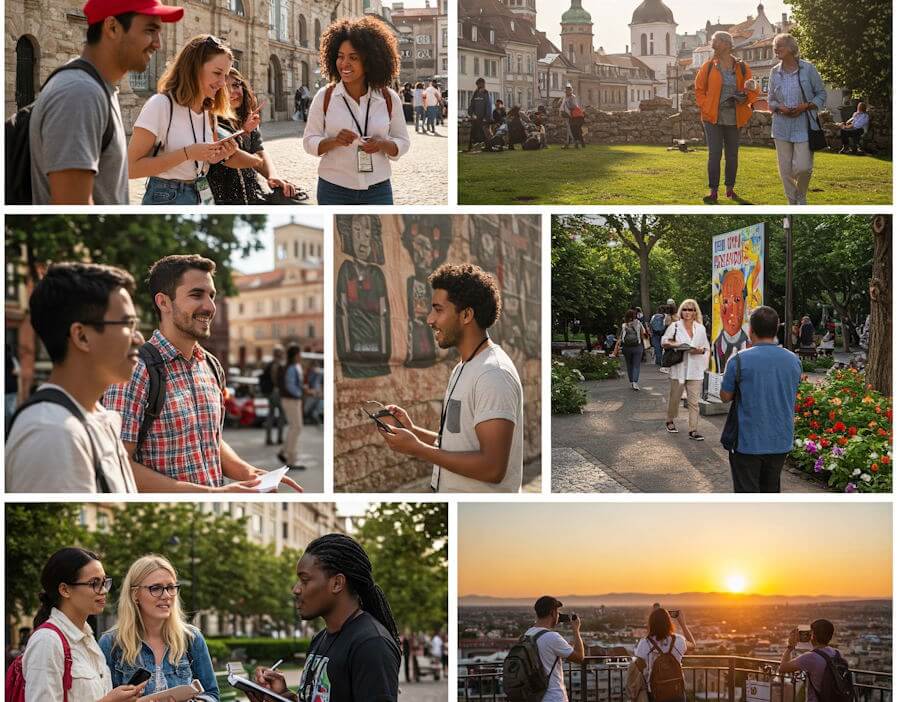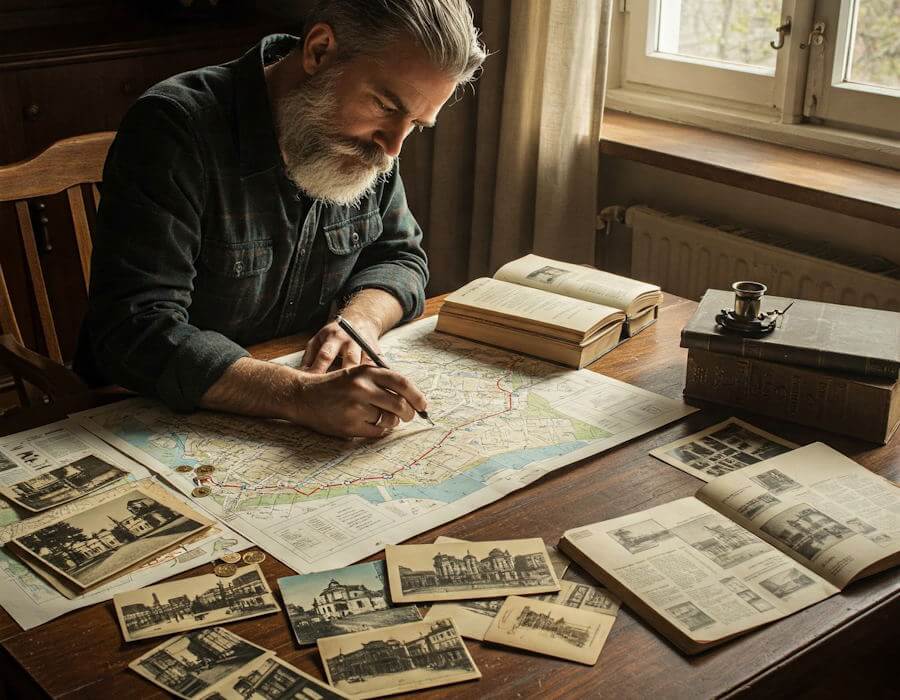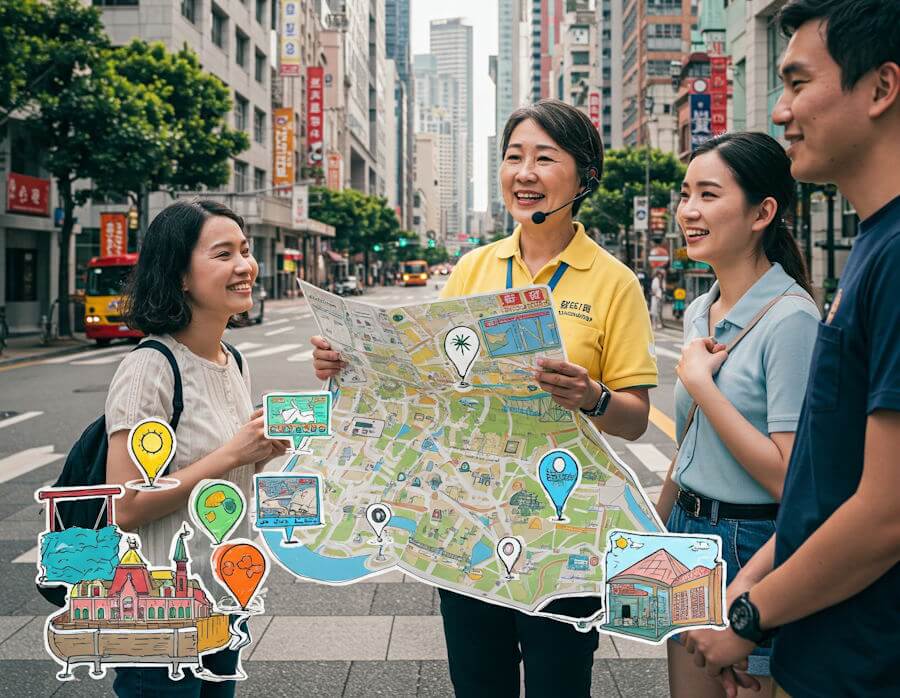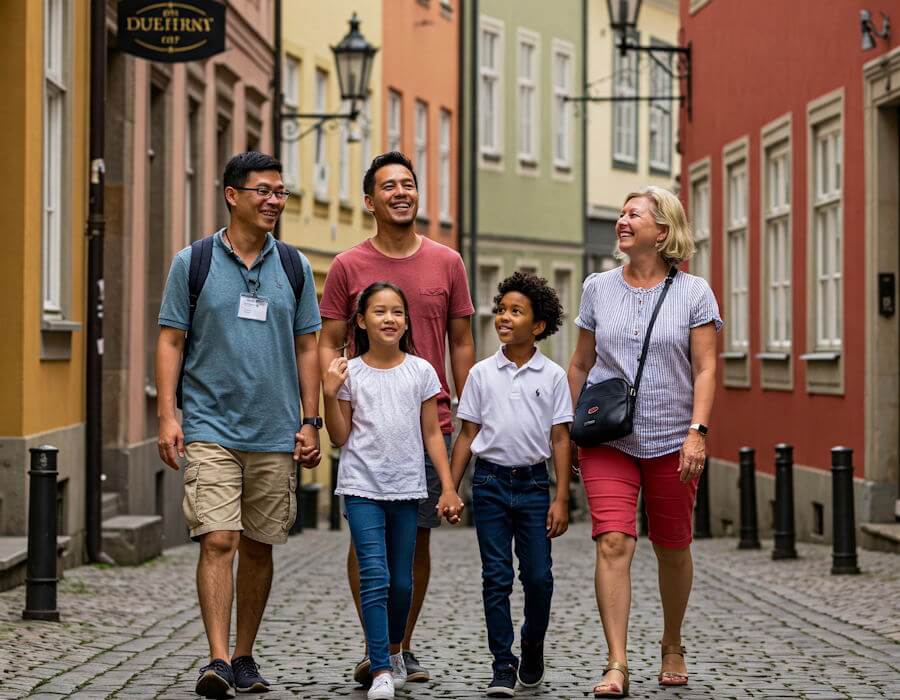Introduction to Urban Exploration
Urban exploration, often known as “urbex,” involves the art of discovering and experiencing the unique aspects of cities that are often overlooked. This practice has grown increasingly popular within the cultural travel landscape, as many individuals seek to connect with their surroundings on a deeper level. In an era where travel has become more accessible, urban exploration encourages locals and tourists alike to uncover the hidden gems of their own cities. By forging unique city tours, participants engage with their environment in a meaningful way, ultimately fostering a greater appreciation for their locales.
One of the primary benefits of urban exploration is the opportunity to gain a fresh perspective on familiar territories. Rather than just visiting well-known landmarks, individuals can delve into the lesser-known, yet equally captivating, areas that define the spirit of a city. This not only enriches the travel experience but also sparks creativity as explorers learn to view their surroundings through a new lens. Walking down quiet streets, visiting obscure galleries, or participating in local events can unveil aspects of urban life that were previously unrecognized.
Moreover, personalized city tours can inspire collaboration and community engagement. Individuals can design enjoyable itineraries that reflect their interests, whether it be a food tour focusing on local cuisines or an artistic journey exploring vibrant street art. This unique customization allows for a memorable experience that aligns perfectly with one’s passions, thus highlighting the diversity of urban environments. By embracing urban exploration, travelers are not only enhancing their travel experiences but also contributing to the cultural narrative of their cities, sharing stories that resonate within their communities.
Tour Idea 1: Foodie Adventure
Embarking on a foodie adventure is an excellent way to explore a city while indulging in its unique culinary offerings. To create a memorable food-focused city tour, one should begin by researching and selecting a diverse array of dining options, including local restaurants, celebrated food trucks, and vibrant markets. This variety will allow participants to experience a range of flavors and styles, capturing the essence of the local cuisine.
When curating the itinerary, it is essential to prioritize eateries known for their signature dishes or innovative culinary approaches. Look for spots that emphasize fresh, locally sourced ingredients and traditional preparation methods. Consider including a mix of casual dining, upscale restaurants, and hidden gems frequented by locals for a well-rounded experience. Additionally, be open to trying unique dishes that reflect the city’s distinct food culture, which may include regional specialties or fusion cuisine.
Incorporating food-related activities can further enrich the tour. One idea is to schedule a cooking class, providing participants with a hands-on opportunity to learn how to prepare local dishes. This interactive experience not only enhances culinary knowledge but also fosters a deeper appreciation for the local ingredients and cooking techniques. Taste-testing sessions, where participants sample various foods and beverages at different stops, can also be fun and educational ways to engage with the city’s culinary scene.
Additionally, visiting local markets can offer insights into everyday food practices and the availability of seasonal ingredients. Engaging with local vendors can add depth to the experience, as they are often eager to share their stories and cultural significance related to the produce they sell. Overall, a foodie adventure serves as an exciting and delicious way to connect with the city, bringing individuals closer to its culture through the shared experience of food.
Tour Idea 2: Historical Landmarks Walk
Embarking on a city tour that highlights historical landmarks can be an enriching experience for both the guide and participants. Historical landmarks serve as tangible connections to the past, allowing visitors to engage with the stories that shaped the cities they explore. To begin planning an effective historical landmarks walk, it is essential to research significant sites within a given area. Understanding the historical importance of these locations will not only add depth to your explanations but will also enhance the overall narrative of the tour.
Start by identifying key historical landmarks that align with the theme of your walk. This could include iconic buildings, monuments, or sites of historic events. Utilize local archives, museums, and reputable online resources to gather context and anecdotes that bring each landmark to life. Share intriguing stories or lesser-known facts to captivate your audience’s attention. For example, recounting a local legend associated with a monument can foster engagement and investment in the tour.
As you map out your route, consider the logistical aspects of the walk. The journey should be manageable, avoiding overly long distances or difficult terrains that may discourage participants. Aim to include a variety of landmarks within a compact area to maintain interest and provide ample time for exploration. If possible, incorporate a balance between interior and exterior sites to allow for breaks from the outdoors while still enjoying the history. Additionally, decide whether your tour will be guided or self-paced. Guided tours offer the advantage of personal interaction and spontaneous Q&A sessions, whereas self-paced tours provide flexibility and allow participants to dive deeper into their points of interest. Regardless of the format, historical landmarks provide a treasure trove of material to create an unforgettable city tour experience.
Tour Idea 3: Art and Culture Exploration
One of the most enriching approaches to designing a city tour is to center it around the local art and cultural scene. Engaging with the artistic pulse of a city offers visitors both an aesthetic and educational experience, revealing the nuances of the locale through its creative expressions. Begin by identifying key art galleries that reflect the diverse styles and histories of the region. Many cities boast not only established institutions but also independent galleries that showcase emerging artists, providing an excellent platform for discovery.
In addition to galleries, consider including street art as a significant aspect of your tour. Many urban areas are transformed into open-air galleries through the efforts of local artisans and muralists. Offering walking routes that emphasize these artistic installations can evoke conversations about cultural commentary, social movements, and the role of public art in community engagement. Be sure to check for any street art festivals or events, as these gatherings often feature live art demonstrations and local vendors, enriching the experience.
Theater and performance art also play a vital role in the artistic landscape of a city. Integrate visits to historic theaters or contemporary performing arts venues where visitors can experience live shows, from plays and musicals to dance recitals. Keep an eye out for local events and festivals celebrating art, such as film festivals, art walks, or cultural celebrations. Attending performances or engaging in discussions with local artists can provide deeper insight into the cultural fabric of the city.
Incorporating workshops or interactive experiences into the tour highlights not only the importance of art but also the vibrant community that cultivates it. Offering sessions that enable attendees to create their own art or delve into the local creative process fosters a dynamic relationship between visitors and the local culture. This immersive exploration will not only enhance the visitor experience but also leave a lasting impression of the city’s artistic identity.
Tour Idea 4: Nature and Urban Green Spaces
Creating a city tour that focuses on nature and urban green spaces offers a refreshing escape from the hustle and bustle typically found in urban environments. This type of tour can provide participants with the opportunity to explore parks, botanical gardens, and picturesque riverside walks, all of which contribute to a well-rounded metropolitan experience. By incorporating these elements, tourists can enjoy the serenity that nature offers while still immersed in the city’s vibrant culture.
One of the primary benefits of including green spaces in your city tour is the positive impact nature has on mental well-being. Studies have shown that spending time outdoors can reduce stress and anxiety, improve mood, and increase overall happiness. This underscores the importance of integrating outdoor activities into your itinerary, whether through leisurely strolls in public parks or more structured guided nature walks. Parks often serve as community hubs, showcasing local flora and fauna, and providing insight into the area’s natural history.
As part of your nature-focused tour, consider including a visit to a botanical garden. These sites not only present a stunning collection of plant life but also educate visitors about conservation and sustainability practices. They often host workshops and guided tours that can further enhance the experience. Furthermore, riverside walks provide an excellent opportunity for a scenic route, offering moments of tranquility beside flowing waters and the chance to observe wildlife.
Moreover, plan to include outdoor activities such as picnics in the park. This not only allows for relaxation but also encourages participants to partake in the natural ambiance that exists within the city. Ultimately, a tour centered around nature and urban green spaces not only promotes physical activity but also fosters a deeper connection between individuals and their urban surroundings, culminating in a holistic city exploration experience.
Tour Idea 5: Hidden Gems and Local Secrets
Exploring a city through its hidden gems and local secrets can transform a typical outing into an extraordinary adventure. These lesser-known spots often hold the key to unique cultural experiences and authentic interactions that are not typically highlighted in traditional tourist guides. To embark on this intriguing journey, one must first prioritize research. Utilize a variety of resources such as blogs, travel forums, and local guides that emphasize off-the-beaten-path attractions.
Social media platforms have emerged as invaluable tools in uncovering these hidden treasures. Instagram, for instance, can be browsed using specific hashtags related to your destination, providing a visual glimpse of lesser-known sites. By following local influencers or city-specific accounts, you can discover numerous quaint shops, secret bars, and intriguing locations that radiate charm. For example, you might stumble upon a cozy café tucked away in a narrow alley that serves the best coffee in town, or a vintage bookstore that hosts weekly poetry readings.
Moreover, engaging with locals can enhance your exploration significantly. Conversations with residents can lead to revealing insights about their favorite spots, many of which may not be listed in mainstream travel recommendations. Local markets, hidden parks, and unique artisan stores often come alive through the stories shared by the people who frequent them. Don’t hesitate to ask baristas, shop owners, or even fellow diners for their personal suggestions; you might uncover a hidden gem that becomes the highlight of your visit.
In essence, navigating a city through its hidden gems invites curiosity and fosters discovery. By utilizing social media resources and connecting with locals, you will enhance your experience and return home with a richer understanding of the city’s character beyond the obvious attractions.
Planning Your Tour: What You Need to Know
Embarking on a city tour requires careful planning to ensure a memorable and enjoyable experience. One of the first steps in organizing your tour is selecting the best routes. Consider the city’s attractions, landmarks, and hidden gems you wish to visit. Effective route planning will prevent backtracking and save valuable time. Mapping out a logical path not only enhances the sightseeing experience but also allows for better time management throughout the day.
Timing is another crucial factor to take into account when planning your city tour. Early mornings often provide a quieter atmosphere, allowing for a more intimate encounter with popular sites. Conversely, afternoons may offer lively street scenes and bustling markets. By considering the time of day to visit specific locations, you can optimize your experience and avoid crowds during peak hours.
Transportation options play an essential role in the logistics of your tour. City tours can be conducted using various modes of transport, including walking, biking, public transit, or taxis. Walking tours afford travelers the chance to immerse themselves in the environment, while biking can cover greater distances in a shorter time. Public transport may provide cost-effective options, but consider the schedules and routes of buses or trains to ensure smooth navigation.
Creating a balanced itinerary is equally relevant for a successful city tour. While it is vital to include planned activities, it is equally essential to allow room for spontaneity. Unexpected moments, such as stumbling upon a local café or street performance, often lead to the most cherished memories. By scheduling key destinations yet leaving time for exploration, travelers can experience the city authentically, embracing both the well-known and the undiscovered.
Sustainable City Touring Practices
As urban exploration becomes increasingly popular, it is essential to consider sustainable city touring practices that minimize environmental impact while enhancing the overall travel experience. One of the most effective methods is utilizing public transportation systems available in most cities. By opting for buses, trams, or trains, travelers can significantly reduce their carbon footprint compared to individual car use. Furthermore, public transit often provides a unique perspective of the city, allowing one to engage with local culture and daily life.
Another way to ensure a sustainable city tour is by supporting local businesses. Tourists can seek out local restaurants, shops, and service providers rather than large, multinational corporations, which often overlook local culture and economy. Purchasing goods or dining at these establishments promotes the preservation of local heritage while benefiting the community financially. Many cities now offer guided tours that introduce visitors to local vendors and artisans, which highlights the importance of such contributions.
Additionally, when planning city tours, eco-friendly choices should be a priority. This could include selecting accommodation that employs green practices, such as energy-efficient lighting and waste reduction strategies. Tourists can also reduce waste by carrying reusable bottles, bags, and containers, minimizing single-use plastics that typically contribute to urban pollution. When exploring cities, favoring walking or cycling not only supports a lower environmental impact but also allows for a more intimate connection with the surroundings.
Ultimately, adopting sustainable practices during city tours encourages travelers to reflect critically on their roles as urban explorers. By acknowledging the consequences of their touring habits, individuals can create a positive impact while enjoying the beauty and richness that cities have to offer.
Sharing Your Experience: Documenting Your Tour
Documenting your city tour experience is a fantastic way to not only preserve your memories but also to inspire others who may be considering similar adventures. With the rise of digital platforms, sharing your journey can easily be done through various mediums such as blogs, vlogs, and social media. Each platform offers unique opportunities to engage with your audience and convey your personal experiences.
When capturing your tour in photos, it is essential to focus on both composition and storytelling. Utilize natural lighting as much as possible to enhance your images, and don’t shy away from various perspectives. Think about the narrative you want to share; a simple photo of a street can tell a myriad of stories if captured from the right angle. Aim to include a mix of wide shots that capture the essence of your surroundings and close-ups that showcase details of your experiences.
In addition to visual content, articulating your experiences through writing can significantly enrich your documentation. Crafting captivating stories provides context for your images and allows your audience to connect with your journey on a deeper level. When writing, emphasize your emotions, challenges, and standout moments. Each tour will have its unique flavor, and sharing your personal insights will provide readers with a genuine understanding of your experiences.
Moreover, leveraging social media enhances the visibility of your content. Use relevant hashtags to reach a broader audience and engage with individuals who share similar interests. Platforms like Instagram and Twitter allow you to connect with fellow travelers and enthusiasts, creating a sense of community around your documented adventures. The act of sharing your experiences not only enriches your narrative but can also inspire others to embark on their own explorations, fostering a love for travel and discovery.
Conclusion: Get Ready to Explore!
As we conclude this exploration of inspiring city tour ideas, it is essential to note that the most rewarding adventures often come from spontaneity and a willingness to discover the hidden gems in our surroundings. Whether you are in an unfamiliar city or your hometown, there are endless opportunities waiting to be uncovered right at your doorstep. These tours encourage individuals to delve into their local environments, enabling a deeper appreciation for the culture, history, and unique offerings of the city.
Utilizing the ideas presented throughout this post, you can curate experiences that align with your interests and uncover stories that may have previously gone unnoticed. From historical walks that delve into the rich past of your area to gastronomic adventures that highlight local cuisine, the potential to create memorable tours is vast. Moreover, these activities not only enhance your understanding of your city but also foster connections with fellow explorers who share your enthusiasm.
Remember, the beauty of city exploration often lies in the unexpected moments and encounters that can transform a simple outing into a cherished memory. With a little creativity and an open mind, you are well-equipped to craft your own city tours that will rejuvenate your sense of wonder. So, gather your friends, family, or venture out solo, and embark on a journey that showcases your city’s personality, unique landmarks, and hidden treasures.
In essence, now is the time to put these inspiring city tour ideas into action. Embrace the excitement of exploring and let your curiosity guide you as you discover all that your city has to offer.




